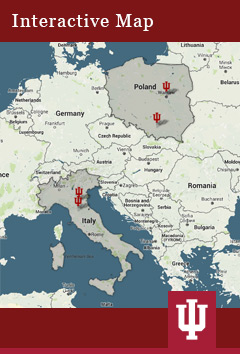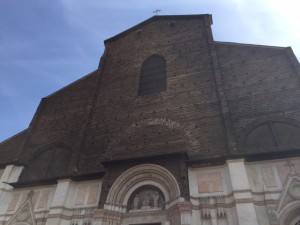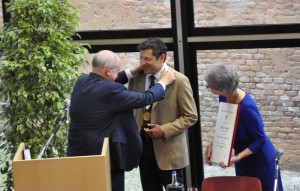A big celebration in Bologna
Almost immediately upon setting foot in the narrow, cobbled streets of Bologna, it’s easy to see how the late Indiana University professor and Italian literature scholar Mark Musa would’ve been captivated by this most charming city. It’s also easy to recognize what five decades of IU students — who have studied here as a result of Musa’s vision to connect Bologna to Bloomington, Ind., and create one of IU’s most successful study abroad programs — have come to adore about one of Italy’s most important academic, artistic and cultural centers.
“Bologna è bella!,” the influential Italian poet and teacher Giosuè Carducci declared, and what better way to describe a city that, for centuries, has inspired so many visitors with its magnificent ancient architecture and sculptures, vibrant colors and sensational tastes. [My stomach can vouch: Italian pasta isn’t truly pasta until you’ve visited Bologna.] It is nearly impossible to not stop at every turn and admire a powerful work of art, such as the famous Fontana del Nettuno (Fountain of Neptune) statue in the Quadrilatero, a crossroads of streets bordered by some of the most important monuments and buildings in Bologna. The fantastic fountain stands next to to the dazzling Piazza Maggiore, the city’s central square which includes the magnificent Basilica of San Petronio, also known as the Duomo of Bologna and one of the largest churches in the world.
Here in Bologna is also the oldest continuously operating university in the Western world, the University of Bologna. Since its earliest days in the late 11th century, when masters of grammar, rhetoric and logic began to devote themselves to the study and teaching of law, the university has built a reputation of international acclaim, attracting such luminaries as Thomas Becket, Erasmus of Rotterdam and Nicolaus Copernicus, among many other famous historical figures who came to the city from all over Europe to study with the university’s prominent scholars.
IU was among the first U.S. universities to establish a study abroad program at the University of Bologna. Professor Musa, a renowned Dante scholar, established the bilateral exchange, which has since been expanded to a consortium of 15 U.S. colleges and universities managed by IU’s Office of Overseas Study. Since the first group of students in 1965-66, more than 1,500 alumni have completed the immersive Italian program, and over the past two decades, 280 Italian undergraduate students and dozens of Italian graduate students have come to the U.S. to study at IU and other universities with which IU partners in the consortium. Those students are served by an IU-operated office with a resident program director, Andrea Ricci.
The program has, in the words of IU President Michael A. McRobbie, become one of the “cornerstones of IU’s long and extensive history of international partnership and engagement.”
“The mother of all universities”
On Friday, McRobbie and his fellow IU delegation members had the opportunity to participate in the historic 50th anniversary celebration of this cornerstone, one with a university that, along with other centuries-old European academic institutions, essentially created the modern university as we know it today.
Faculties. Curricula. Conservatories. Examinations. Degrees. All of these now common terms associated with today’s universities were first developed in the old European universities like the University of Bologna, which was founded in 1088.
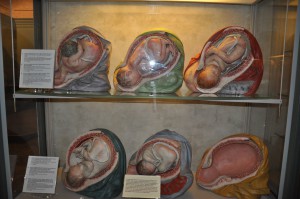
Three-dimensional wax models, featured in the Palazzo Poggi Museum, depict babies developing in the womb.
Indeed, the University of Bologna is frequently called the “mother all of universities” for how it conceived not just the common structure and processes of today’s universities, but also the principles of excellence in education, research and creative activity that these institutions passionately pursue on behalf of their students.
The Palazzo Poggi Museum at the University of Bologna, which McRobbie and several other delegation members toured today, offers a fascinating reflection of the mission of the modern university. The museum painstakingly recreates the laboratories and collections from the old Istituto delle Scienze, which was housed in the rooms of the Palazzo Poggi building from 1711 to 1799. In its time, the Istituto delle Scienze included various laboratories in which cutting-edge research spanned a wide range of fields, including geographical and nautical science, military architecture, experimental physics, natural history, chemistry, anatomy and obstetrics.
The museum, which opened in 2000, has an astonishing array of items in all of these areas — including carefully preserved fish and other unusual natural specimens from the collection of Ulisse Aldrovandi (1522-1605), the founder of modern natural history; three-dimensional wax models depicting babies developing in the womb; and intricate wooden models illustrating the evolution of military fortification systems. All of these collections are set against an extraordinary backdrop of 16th-century wall paintings depicting famous figures and events in history.
In the same Palazzo Poggi building is a younger museum, the Museo Europeo Degli Studenti, which is devoted to the lives of students through the ages. The facility features drawings, sculptures, objects, books, illuminated manuscripts and reconstructions of various environments that enable visitors to explore different aspects and events in the history of student life and gain a greater appreciation for how much the university student has changed — or, in some instances, remained the same — over centuries.
Full-on immersion, a life-altering experience
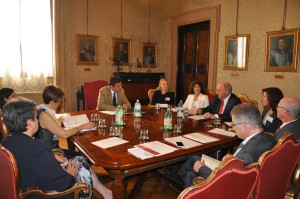
IU delegation members meet with University of Bologna President Francesco Ubertini, seated fourth from left.
The delegation’s museum visits served as a fitting lead-in to a lively mid-afternoon discussion between IU delegation members and current president of the University of Bologna Francesco Ubertini. During the meeting, President McRobbie described IU’s longstanding relationship with Bologna through the Bologna Consortial Studies Program, which offers qualified undergraduate students an opportunity to study for a full academic year or semester at the University of Bologna for U.S. college credit.
He praised the number of graduates from IU who have passed through the program and gone on to distinguished careers in diverse fields around the world. He also discussed IU’s efforts to diversify its student body and provide its graduates with the knowledge and experiences they need to succeed in today’s increasingly connected global marketplace.
To this end, IU Vice President for International Affairs David Zaret and Hannah Buxbaum, academic director of IU’s newly opened gateway office in Berlin, met Friday with University of Bologna faculty in areas in which IU and Bologna have similar strengths to explore new undergraduate and graduate student exchanges and potential collaborations between the two universities’ scholars and researchers.
Presidents McRobbie and Ubertini agreed strongly that these exchanges, in particular study abroad for students, should remain a priority.
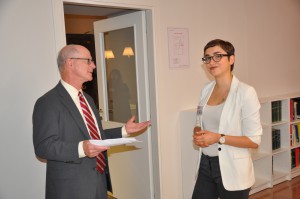
IU Vice President for International Affairs David Zaret chats with IU student Francisca Figueroa, who is participating in the study abroad program in Bologna.
Earlier this morning, members of the delegation had the privilege of spending some time with a number of IU students studying here in Bologna this summer as part of the university-led consortium. Among them was Francisca Figueroa, an Indianapolis native seeking to squeeze every last learning opportunity out of her time studying here in Bologna. Figueroa, a Mexican-American and IU Hudson Holland Scholar, is pursuing multiple majors, including an independent study major in global food sustainability, which has her working with IU Distinguished Professor of Anthropology Richard Wilk, an authority on the history of food globalization. While studying in Bologna this summer, she is also working on a film documentary on the role of the Italian mother in sustainability. And just last year she traveled as a U.S. Student Ambassador to Milan to work at a major international conference centered on the environmental, social and economic complexities of the global food system.
Figueroa’s story, which truly would require several more blog chapters, was just one of the current student testimonials delegation members heard today about the power of a program that fully immerses its young participants in Italian life, learning and culture.
Indeed, all of the program’s students live exclusively with Italian students and enroll directly in University of Bologna courses. Many also perform internships in local museums, schools, law firms, hospitals and other organizations. And their year concludes with oral examinations in Italian — a daunting challenge for most American students.
An anniversary for the ages
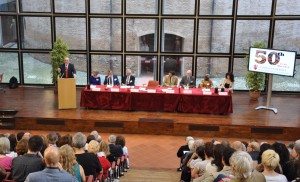
IU President Michael A. McRobbie delivers remarks at the 50th anniversary celebration of the IU Bologna Consortial Studies Program.
Friday afternoon’s joyous 50th anniversary celebration showcased the resounding success of a program that has truly changed the lives of its participants and created lifetime linkages between its many proud alumni.
Indeed, the pride in the air was palpable as Andrea Ricci and Kathleen Sideli, director and managing director of the IU Bologna Consortial Studies Program, respectively, welcomed the past resident directors, managing directors, consortium representatives and overseas study staff who have contributed to a remarkable 50 years of collaboration and greatly enhanced the lives of the program’s alumni, who were also recognized throughout the afternoon.
Many of the former program leaders shared stories with IU delegation members about the many highs and, yes, occasional challenges of a program that has withstood the changes and tumult of the past half century, including the rise of the communist party in the city, the leftist rioting in the 1970s and the tragic bombing, in 1980, of the Bologna train station, which killed 85 people.
The landmark event featured many pleasant surprise moments, as when Mark Musa’s wife, Isabella, upon learning that a student scholarship had been established in honor of her husband, announced that the celebration happened to be taking place on her husband’s birthday.
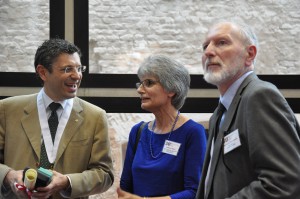
From left: University of Bologna President Francesco Ubertini, Kathleen Sideli, managing director of the Bologna overseas study program and professor Riccardo Giovanelli.
Janis Russell, an IU alumnus and nationally known jazz and blues singer and songwriter, who has performed before President Bill Clinton, Pope John Paul II and Nelson Mandela, later thrilled the 200 or so guests in attendance by breaking into a lilting song about her loving memories of Bloomington and Bologna.
The renowned Italian-born astronomer and professor Riccardo Giovanelli, the first University of Bologna graduate exchange student at IU in 1969-70, also delighted starry-eyed attendees with his humor and remembrances of his time at IU. After graduating from Bologna, Giovanelli entered the graduate program at IU Bloomington as a Fulbright fellow, receiving his Ph.D. in astronomy in 1976. In 1997, he earned the title of Cavaliere della Republica, Italy’s highest ranking honor, by the president of Italy. Currently, he and his wife are on the faculty at Cornell University.
Just a few weeks ago, his name resounded again across the global scientific community, when a team of IU astronomers, who recently found that a small blue galaxy 30 million light-years from Earth could test the Big Bang theory, nicknamed the galaxy “Leoncino” in honor of both its constellation location and in recognition of Giovanelli, who led the group that first identified the galaxy.
Speaking in a soft Italian accent, Giovanelli joked about being the only person on a flight from Indianapolis to Bloomington. (Perfectly deadpan, he added that the flight was “nonstop.”) He then reminisced about what he fondly described as “Bloomington magic,” including playing soccer on Sundays, strolling along the Jordan River and hearing a guitarist play one of his favorite songs, Hoagy Carmichael’s “Stardust,” watching some of the “best basketball ever played” by the 1975-76 championship Hoosiers and meeting his eventual wife, Martha.
“Bloomington will be in my mind for a long, long while,” he said.
Fittingly, the event concluded with McRobbie awarding his University of Bologna counterpart, Ubertini, with IU’s Thomas Hart Benton Mural Medallion, in recognition of the long and successful partnership between their respective institutions.
It was a perfect close to a big day for IU in Bologna, which prominently showcased the power of the university’s partnerships around the world and signaled the promise of even greater global collaboration in the years ahead.
Read more about the 50th anniversary of the IU Bologna Consortial Studies Program, including a detailed history, director and student testimonials, photos and historical documents.
See photos from Friday’s celebration in Bologna.
Tags: Andrea Ricci, BCSP, Bologna, David Zaret, Francesco Ubertini, Francisca Figueroa, Hannah Buxbaum, Istituto delle Science, IU Bologna Consortial Studies Program, IU Europe Gateway, IU Office of Overseas Study, Janis Russell, Kathleen Sideli, Leoncino, Mark Musa, Michael A. McRobbie, Museo Europeo Degli Studenti, Palazzo Poggi Museum, Riccardo Giovanelli, Richard Wilk, Thomas Hart Benton Medallion, University of Bologna

